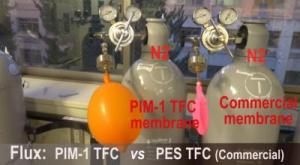 PIM-1 is a highly permeable membrane compared with commercially available ones. The orange balloon on the left illustrates this point as a higher volume of nitrogen gas is able to pass through PIM-1 into the balloon compared with the membrane on the right, connected to the pink balloon. (Credit: Kyoto University iCeMS Public Relations)
PIM-1 is a highly permeable membrane compared with commercially available ones. The orange balloon on the left illustrates this point as a higher volume of nitrogen gas is able to pass through PIM-1 into the balloon compared with the membrane on the right, connected to the pink balloon. (Credit: Kyoto University iCeMS Public Relations)
Industrial processes and consumption of fossil fuels release greenhouse gases, a major cause of global warming. An advanced membrane engineered by an international research team led by Easan Sivaniah at the Institute for Integrated Cell-Material Sciences (iCeMS) of Kyoto University can address this problem by eliminating greenhouse gases from the atmosphere.
Carbon dioxide is the most abundant greenhouse gas and is capable of lingering in the atmosphere for several years. Although, lowering carbon dioxide footprint is the objective of all countries, this greenhouse gas is basically a waste product that involves large processing costs but with less commercial value. In that regard, novel economical techniques are essential to encourage the industry to involve in greenhouse gas capture.
Qilei Song, one of the researchers, said that the advanced membrane called PIM-1 features a network of cavities and channels having a diameter of below 2nm, which are capable of capturing the gases of interest when they pass through the membrane. However, the drawback is their weak initial selectivity due to their intrinsic properties, Song added.
The research team addressed the drawbacks of PIM-1 by heating the membrane at a temperature range of 120-450°C in an oxygen environment. This thermal oxidation process improves the selectivity of the membrane by allowing the oxygen to react with PIM-1, increasing the strength of channels and controlling the size of gate openings connecting the cavities, said Song.
The improved PIM-1 exhibited double the selectivity for carbon dioxide and enabled air to traverse at a rate 100 folds higher than with existing polymers. The advanced membrane can also be used for plastic generation processes, hydrogen gas production, carbon dioxide capture during the burning of fossil fuels and increasing oxygen proportion in air for efficient operation of combustion engines.
The research team actually created a process of generating polymers capable of truly contributing to a sustainable environment, said Sivaniah.
The results are featured in the Nature Communications journal.